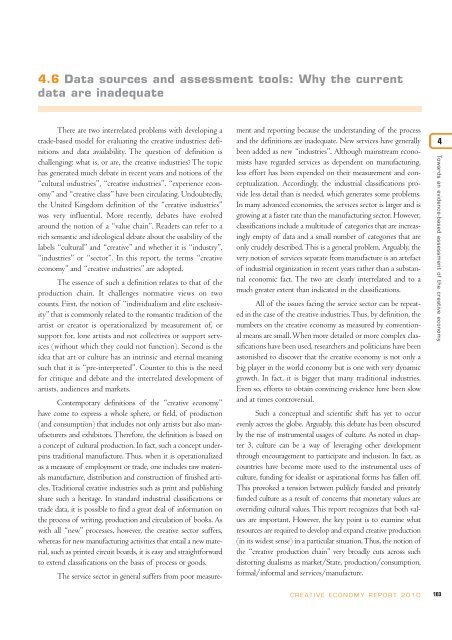Creative Economy: A Feasible Development Option
Creative Economy: A Feasible Development Option
Creative Economy: A Feasible Development Option
- No tags were found...
You also want an ePaper? Increase the reach of your titles
YUMPU automatically turns print PDFs into web optimized ePapers that Google loves.
4.6 Data sources and assessment tools: Why the currentdata are inadequateThere are two interrelated problems with developing atrade-based model for evaluating the creative industries: definitionsand data availability. The question of definition ischallenging: what is, or are, the creative industries? The topichas generated much debate in recent years and notions of the“cultural industries”, “creative industries”, “experience economy”and “creative class” have been circulating. Undoubtedly,the United Kingdom definition of the “creative industries”was very influential. More recently, debates have evolvedaround the notion of a “value chain”. Readers can refer to arich semantic and ideological debate about the usability of thelabels “cultural” and “creative” and whether it is “industry”,“industries” or “sector”. In this report, the terms “creativeeconomy” and “creative industries” are adopted.The essence of such a definition relates to that of theproduction chain. It challenges normative views on twocounts. First, the notion of “individualism and elite exclusivity”that is commonly related to the romantic tradition of theartist or creator is operationalized by measurement of, orsupport for, lone artists and not collectives or support services(without which they could not function). Second is theidea that art or culture has an intrinsic and eternal meaningsuch that it is “pre-interpreted”. Counter to this is the needfor critique and debate and the interrelated development ofartists, audiences and markets.Contemporary definitions of the “creative economy”have come to express a whole sphere, or field, of production(and consumption) that includes not only artists but also manufacturersand exhibitors. Therefore, the definition is based ona concept of cultural production. In fact, such a concept underpinstraditional manufacture. Thus, when it is operationalizedas a measure of employment or trade, one includes raw materialsmanufacture, distribution and construction of finished articles.Traditional creative industries such as print and publishingshare such a heritage. In standard industrial classifications ortrade data, it is possible to find a great deal of information onthe process of writing, production and circulation of books. Aswith all “new” processes, however, the creative sector suffers,whereas for new manufacturing activities that entail a new material,such as printed circuit boards, it is easy and straightforwardto extend classifications on the basis of process or goods.The service sector in general suffers from poor measurementand reporting because the understanding of the processand the definitions are inadequate. New services have generallybeen added as new “industries”. Although mainstream economistshave regarded services as dependent on manufacturing,less effort has been expended on their measurement and conceptualization.Accordingly, the industrial classifications provideless detail than is needed, which generates some problems.In many advanced economies, the services sector is larger and isgrowing at a faster rate than the manufacturing sector. However,classifications include a multitude of categories that are increasinglyempty of data and a small number of categories that areonly crudely described. This is a general problem. Arguably, thevery notion of services separate from manufacture is an artefactof industrial organization in recent years rather than a substantialeconomic fact. The two are clearly interrelated and to amuch greater extent than indicated in the classifications.All of the issues facing the service sector can be repeatedin the case of the creative industries. Thus, by definition, thenumbers on the creative economy as measured by conventionalmeans are small. When more detailed or more complex classificationshave been used, researchers and politicians have beenastonished to discover that the creative economy is not only abig player in the world economy but is one with very dynamicgrowth. In fact, it is bigger that many traditional industries.Even so, efforts to obtain convincing evidence have been slowand at times controversial.Such a conceptual and scientific shift has yet to occurevenly across the globe. Arguably, this debate has been obscuredby the rise of instrumental usages of culture. As noted in chapter3, culture can be a way of leveraging other developmentthrough encouragement to participate and inclusion. In fact, ascountries have become more used to the instrumental uses ofculture, funding for idealist or aspirational forms has fallen off.This provoked a tension between publicly funded and privatelyfunded culture as a result of concerns that monetary values areoverriding cultural values. This report recognizes that both valuesare important. However, the key point is to examine whatresources are required to develop and expand creative production(in its widest sense) in a particular situation. Thus, the notion ofthe “creative production chain” very broadly cuts across suchdistorting dualisms as market/State, production/consumption,formal/informal and services/manufacture.4Towards an evidence-based assessment of the creative economyCREATIVE ECONOMY REPORT 2010103
















